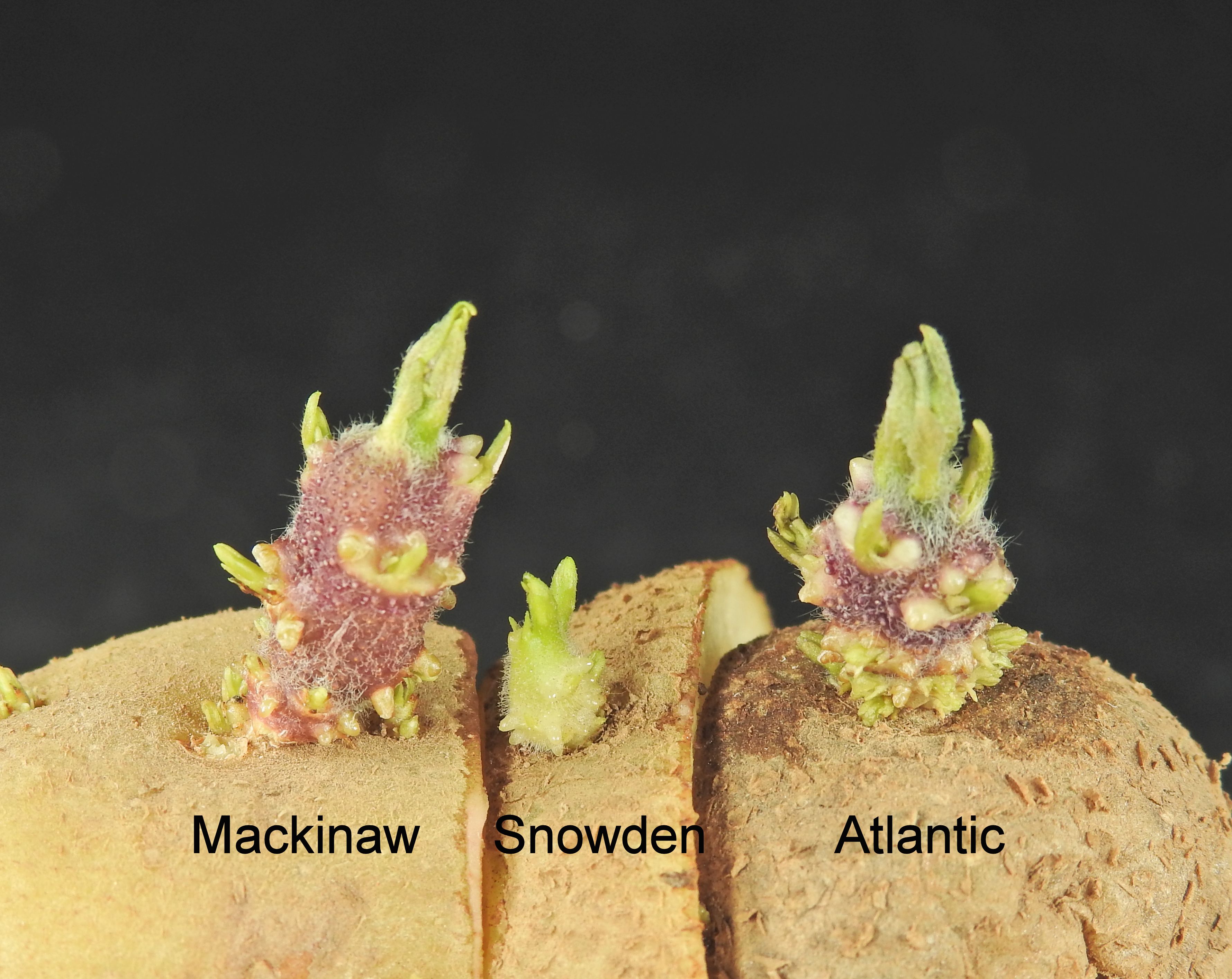Mackinaw
| Denomination: | 'Mackinaw' |
|---|---|
| Botanical Name: | Solanum tuberosum |
| Applicant/Holder: |
The Board of Trustees of Michigan State University 246 Administration Building 325 E. Grand River Avenue, Suite 350 East Lansing, Michigan 48823 United States of America |
| Breeder: |
David S. Douches, Okemos, United States of America |
| Agent in Canada: |
Global Agri Services Inc. 376 New Maryland Highway New Maryland, New Brunswick E3C 1E5 Canada Tel: 506-462-9493 |
| Application Date: | 2020-07-15 |
| Provisional Protection:: | 2020-07-15 |
| Application Number: | 20-10288 |
| Grant of Rights Date: | 2024-09-17 |
| Certificate Number: | 7193 |
| Grant of Rights Termination Date: | 2044-09-17 |
Variety Description
Varieties used for comparison: 'Atlantic' and 'Snowden'
Summary: The lightsprout of 'Mackinaw' is medium sized whereas that of 'Snowden' is very small to small. The lightsprout base of 'Mackinaw' has a strong intensity of anthocyanin colouration while that of 'Snowden' has an absent or very weak intensity of anthocyanin colouration. In relation to the base, the lightsprout tip of 'Mackinaw' is small while those of 'Atlantic' and 'Snowden' are medium sized. The lightsprout tip of 'Mackinaw' has a medium intensity of anthocyanin colouration while that of 'Atlantic' has a weak intensity of anthocyanin colouration and that of 'Snowden' has an absent or very weak intensity of anthocyanin colouration. The lightsprout of 'Mackinaw' has many root tips while the lightsprout of 'Atlantic' has few to a medium number of root tips and that of 'Snowden' has few root tips. The stem of 'Mackinaw' has a low to medium extent of anthocyanin colouration whereas that of 'Atlantic' and 'Snowden' have an absent or very low extent of anthocyanin colouration. The upper side of the leaf of 'Mackinaw' is medium green while those of 'Atlantic' and 'Snowden' are light green. The leaflet blade at the apical rosette of 'Mackinaw' has pubescence while pubescence is absent on those of the reference varieties. The inner side of the corolla of 'Mackinaw' has an absent or very weak intensity of anthocyanin colouration while that of 'Atlantic' has a medium intensity of anthocyanin colouration.
Description:
LIGHTSPROUT: medium sized, ovoid, many root tips, short lateral shoots
LIGHTSPROUT BASE: strong intensity of anthocyanin colouration, medium proportion of blue in anthocyanin colouration, sparse to medium density of pubescence
LIGHTSPROUT TIP: small in relation to base, closed habit, medium intensity of anthocyanin colouration, sparse pubescence
PLANT: foliage structure is intermediate type, where foliage is half open and stems are partly visible, semi-upright growth habit, matures mid to late season
STEM: low to medium extent of anthocyanin colouration halfway up the stem
LEAF: large outline, intermediate to open, weak to medium presence of secondary leaflets, medium green upper side, absent or very low extent of anthocyanin colouration on upper side of midrib, absent or very weak intensity of anthocyanin colouration on upper side of midrib, absent or very low frequency of coalescence of terminal and lateral leaflets
SECOND PAIR OF LATERAL LEAFLETS: very large, leaflet is narrower than long
LEAFLET: absent or very weak degree of waviness of margin, medium depth veins, dull upper side, pubescence of blade at apical rosette present
PEDUNCLE: absent or very low extent of anthocyanin colouration
INFLORESCENCE: high frequency per plant, medium sized
FLOWER BUD: medium to high extent of anthocyanin colouration
COROLLA: medium sized
COROLLA (INNER SIDE): absent or very weak intensity of anthocyanin colouration, absent or low proportion of blue in anthocyanin colouration, absent or very low extent of anthocyanin colouration
TUBER: round, white flesh
TUBER EYE: shallow to medium depth, yellow at base
TUBER SKIN: light beige, absent or very weak to weak anthocyanin colouration in reaction to light
Origin & Breeding History: 'Mackinaw' originated from the cross conducted by the breeders at Michigan State University in East Lansing, Michigan, USA in 2009. The cross was conducted between the varieties 'Saginaw Chipper' and 'Lamoka'. The new variety was selected in 2010 for its tuber colour, shape and processing characteristics. Following selection, the variety was grown in replicated agronomic trials from 2013-2017 to assess disease resistance. Tissue culture production commenced in 2013.
Tests & Trials: The comparative trial for 'Mackinaw' was conducted by Global Agri Services Inc. in Central Blissville, New Brunswick during the 2022 growing season. The field trial consisted of a single, 22 metre long row per variety. Each row contained 70 plants spaced 0.3 metres apart with inter-row spacing of 1.1 metres. Measurements were taken from 10 plants, or 10 parts of plants, of each variety. The mean difference was significant at the 5% probability level based on a paired Student's t-test. Lightsprout characteristics were assessed on 10 tubers harvested from the comparative trial and observed approximately 2.5 to 3 months after sprouting was promoted by exposing the tubers to an external agent.
Click on image for larger view

Potato: 'Mackinaw' (left) with reference varieties 'Atlantic' (right) and 'Snowden' (center)
- Date modified: